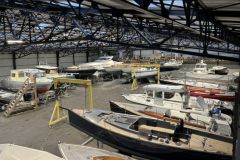A not quite symmetrical boat
how to make a template for a new wall and prepare it in the workshop . During the template tests, it seemed that the boat was perfectly symmetrical. Unfortunately, when it came time to fit the starboard half bulkhead into the hull, that didn't turn out to be so true. Matt does a little grinding to get it in place.
A fully laminated wall
Structurally, the new bulkheads of the sailboat have to be made perfectly solid with the rest of the boat. Matt does not simply glue them together, but makes a structural assembly.
First, he explains the preparation of the epoxy filled with silica powder. Thick and easily workable, it allows him to make a fillet joint, applying it to the periphery of the wall and sculpting it with a sufficiently large radius to distribute the forces well.
Matt then prepares strips of fiberglass cloth, which he impregnates with epoxy resin and arranges in the order of application. He then covers the fillet joint with it before boiling it. The two half bulkheads are then firmly attached to the boat.
A recovery partition
To close the future engine hold and support the cockpit floor, he fills the space between the two new half bulkheads. To do this, he cuts a sandwich panel recovered from the removal of the old ballast tanks. He then repeats the layering operation.
The new bulkhead is now in place, the "first stone" of the new boat.









